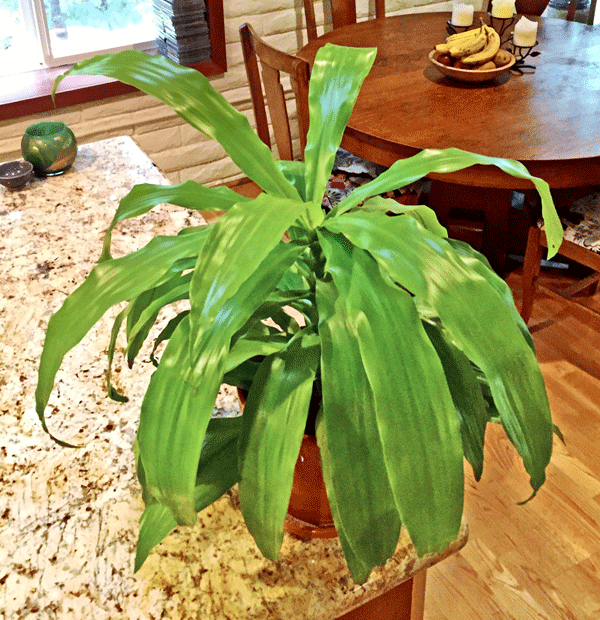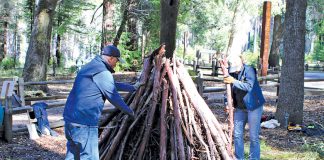Some of my houseplants look a little sad. They were forced to give up their regular place for the Christmas tree and table top decorations and the leaves are droopy. They need to be returned to normal where they can feed on toxins. Houseplants absorb toxins from the air in your house. We spend more time indoors in the winter and create more toxins. The plant’s natural anti-toxin job is an important function so let your houseplants work for you to keep clean air in your house.
It’s amazing how many potential pollutants can be found in a home. For most of a winter day, our homes are closed tight with no windows or doors open to let out pollutants and let fresh air circulate. Toxins such as benzene, formaldehyde, and trichloroethylene can be released from furniture upholstery, carpets, cleaning products, paint, plastics and rubber. Carbon monoxide from the incomplete burning of wood and nitrogen oxides from cigarette smoke, vehicle exhaust and smog can also be present in indoor air.
Then there are airborne biological pollutants. These include bacteria, viruses, animal dander and dried cat saliva, house dust and pollen. House mites, the source of one of the most powerful biological allergens grow in damp warm environments. Mold and mildew grow in moist places like central heating systems and are just one more source of indoor pollution.
The first list of air-filtering plants was compiled by NASA as part of a clean air study published in 1989 which researched ways to clean the air in space stations. As well as absorbing carbon dioxide and releasing oxygen, as all plants do, these plants also eliminated significant amounts of benzene, formaldehyde and trichloroethylene. Other studies added to the list of chemical pollutants and the best plants to remove them.
NASA researchers suggest that the most efficient air cleaning occurs with at least one plant per 100 square feet. Even the microorganisms in potting soil remove some toxins. Yikes, who knew all that was going on right under our noses?
Some of the easiest houseplants to grow are some of the best to have in the home. Just about all the potted palms are good. Also rubber plant, dracaena ‘Janet Craig’, philodendron, Boston fern, ficus, peace lily, Chinese evergreen, spider plant, liriope, snake plant, pathos, English ivy and phalaenopsis orchids are high on the list.
Caring for your houseplants in winter will keep them healthy. Remove dust which blocks light from getting to leaves. I use a moist cloth as it’s too much hassle to drag them to the shower.
Water just enough to keep the soil from going totally dry. Poke your finger into the soil. As a rule of thumb, if your plant is in a 4-6″ pot, let the soil dry half an inch down between watering times, then water thoroughly with room temperature water. Don’t let the pot sit in a saucer with water for over an hour or the roots will rot. If your plant is in an 8-12″ pot, let the soil dry to 1-2″ down before watering and if you have a bigger specimen, the soil should be dry 2-3″ down before watering. Don’t panic if this takes 2-3 weeks before the soil has dried sufficiently for a plant in a big pot. A moisture meter is very helpful for your larger plants.
Fertilize less often. Some houseplant growers skip fertilizing in December and January starting up again with half strength fertilizer in mid-February. Think of your houseplants as essentially dormant in winter. They need fertilizer only when active growth resumes.
Here in the Santa CruzMountains many of us live under trees that block available light during the winter and cloudy days can further lower the amount of light your plants receive. Move plants into the best light you have. To avoid unnecessary trauma, don’t repot a plant in winter. If you’ve acquired a new plant, it’s best to put it inside the next size pot for the time being and replant it when the growing season resumes in March or April. Most plants grow happily for years in the same pot and soil with proper fertilizing during the growing season.
Plain green leafy types do best when there’s less light. Schefflera, arboricola and philodendrons like heart-leafed, selloum and split-leafed, pothos, Chinese evergreen, peace lily and ferns look good even in dreary conditions. They come from the understory of jungles and grow naturally in low-light areas. Don’t overwater and they’ll be happy.
I’m going to get more indoor plants for my own home and choose from those that filter the air best.
Jan Nelson, a landscape designer and California certified nursery professional, will answer questions about gardening in the Santa Cruz Mountains. E-mail her at ja******@*ol.com, or visit www.jannelsonlandscapedesign.com to view past columns and pictures.
����>











